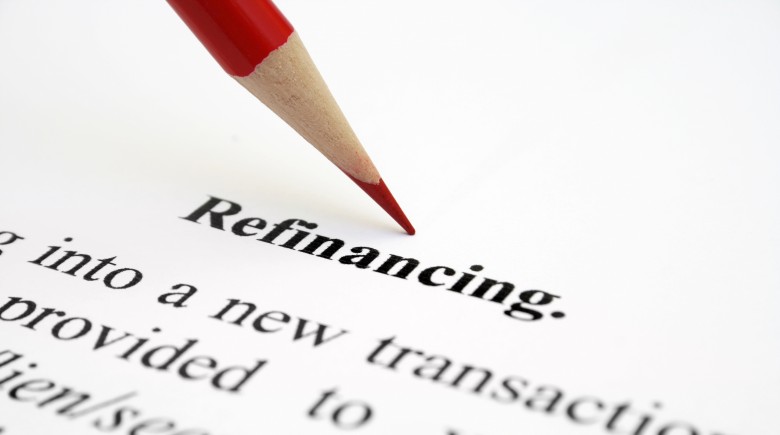Mortgage interest rates are rising, but this doesn’t mean you’ve missed the opportunity to refinance your first mortgage loan. Interest rates normally rise and fall according to market trends, and any drop in rates typically triggers a surge of mortgage applications for refinances and new purchases. However, mortgage rates don’t remain low forever. If you’re thinking about refinancing your mortgage loan, now’s the time to act.
What is a Mortgage Refinancing?
A mortgage refinance is a common real estate transaction in which an owner takes out a new mortgage loan. The new loan replaces the old, and typically features better terms. For those paying a high interest rate, refinancing can open the door to a low, fixed rate and a cheaper home loan payment.
But refinancing isn’t without its headaches. To qualify, you’ll have to complete a new home loan application and wait for the lender to approve the loan. The lender will ask to see your income statements, bank statements, plus the bank will check your credit score. Don’t think that you’ll be approved simply because you already own the house and pay your mortgage on time each month. Lenders base approvals on your present financing standing, and any changes to your income or credit history can stop a refinance.
Refinancing with a Second Mortgage
If you’re refinancing your mortgage, a change in your income and credit aren’t the only issues you may encounter. If you have a second mortgage on your house, such as a home equity loan or a home equity line credit, refinancing can get a bit complicated. It’s not impossible, but you may have to jump through a few hoops. Let me explain.
A second mortgage lets you borrow against your equity, and this is an excellent way to acquire funds to make home improvements or pay off debt. Most people who take out a home equity loan or home equity line of credit already have an existing mortgage, hence the term “second mortgage.” A first mortgage (or primary mortgage) always takes priority over a second mortgage. Therefore, if you were to default on both mortgages, your primary lender is first in line to foreclosure the property.
This makes sense from a financial standpoint. The first mortgage existed before the second mortgage, thus your primary lender should get paid first. But this reasoning can create problems when you’re refinancing with a second mortgage. Because a refinance actually pays off your first mortgage and creates a new loan, the elimination of your original mortgage moves your second mortgage to first place. As you can probably see, this doesn’t work for many refinance lenders. If they can’t assume the first mortgage position, the refinance will not happen.
What are Your Options?
There are ways around this hurdle and a second mortgage doesn’t have to stop a refinance. Two options are available to you:
1. Resubordination – To make a refinance happen, your refinance lender can send a resubordination request to your second mortgage lender. At this time, your second mortgage lender can agree to remain a second lien holder, allowing your refinance lender to take first place. Understand that your second mortgage lender isn’t obligated to accept the new lender’s offer, although most will.
2. Refinance and combine both loans. If your second mortgage lender doesn’t respond favorably to the resubordination request, there’s the option of replacing your first and second mortgage with a single loan. For this to work, the refinance lender will have to approve you for a larger mortgage. After closing, the new mortgage pays off your first and second mortgage.
Mortgage interest rates are rising, but this doesn’t mean you’ve missed the opportunity to refinance your first mortgage loan. Interest rates normally rise and fall according to market trends, and any drop in rates typically triggers a surge of mortgage applications for refinances and new purchases. However, mortgage rates don’t remain low forever. If you’re thinking about refinancing your mortgage loan, now’s the time to act.
What is a Mortgage Refinancing?
A mortgage refinance is a common real estate transaction in which an owner takes out a new mortgage loan. The new loan replaces the old, and typically features better terms. For those paying a high interest rate, refinancing can open the door to a low, fixed rate and a cheaper home loan payment.
But refinancing isn’t without its headaches. To qualify, you’ll have to complete a new home loan application and wait for the lender to approve the loan. The lender will ask to see your income statements, bank statements, plus the bank will check your credit score. Don’t think that you’ll be approved simply because you already own the house and pay your mortgage on time each month. Lenders base approvals on your present financing standing, and any changes to your income or credit history can stop a refinance.
Refinancing with a Second Mortgage
If you’re refinancing your mortgage, a change in your income and credit aren’t the only issues you may encounter. If you have a second mortgage on your house, such as a home equity loan or a home equity line credit, refinancing can get a bit complicated. It’s not impossible, but you may have to jump through a few hoops. Let me explain.
A second mortgage lets you borrow against your equity, and this is an excellent way to acquire funds to make home improvements or pay off debt. Most people who take out a home equity loan or home equity line of credit already have an existing mortgage, hence the term “second mortgage.” A first mortgage (or primary mortgage) always takes priority over a second mortgage. Therefore, if you were to default on both mortgages, your primary lender is first in line to foreclosure the property.
This makes sense from a financial standpoint. The first mortgage existed before the second mortgage, thus your primary lender should get paid first. But this reasoning can create problems when you’re refinancing with a second mortgage. Because a refinance actually pays off your first mortgage and creates a new loan, the elimination of your original mortgage moves your second mortgage to first place. As you can probably see, this doesn’t work for many refinance lenders. If they can’t assume the first mortgage position, the refinance will not happen.
What are Your Options?
There are ways around this hurdle and a second mortgage doesn’t have to stop a refinance. Two options are available to you:
1. Resubordination – To make a refinance happen, your refinance lender can send a resubordination request to your second mortgage lender. At this time, your second mortgage lender can agree to remain a second lien holder, allowing your refinance lender to take first place. Understand that your second mortgage lender isn’t obligated to accept the new lender’s offer, although most will.
2. Refinance and combine both loans. If your second mortgage lender doesn’t respond favorably to the resubordination request, there’s the option of replacing your first and second mortgage with a single loan. For this to work, the refinance lender will have to approve you for a larger mortgage. After closing, the new mortgage pays off your first and second mortgage.







